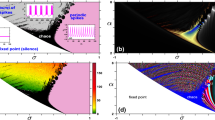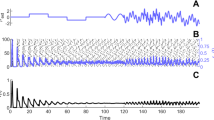Summary
We investigate the phenomenon of epileptiform activity using a discrete model of cortical neural networks. Our model is reduced to the elementary features of neurons and assumes simplified dynamics of action potentials and postsynaptic potentials. The discrete model provides a comparably high simulation speed which allows the rendering of phase diagrams and simulations of large neural networks in reasonable time. Further the reduction to the basic features of neurons provides insight into the essentials of a possible mechanism of epilepsy. Our computer simulations suggest that the detailed dynamics of postsynaptic and action potentials are not indispensable for obtaining epileptiform behavior on the system level. The simulation results of autonomously evolving networks exhibit a regime in which the network dynamics spontaneously switch between fluctuating and oscillating behavior and produce isolated network spikes without external stimulation. Inhibitory neurons have been found to play an important part in the synchronization of neural firing: an increased number of synapses established by inhibitory neurons onto other neurons induces a transition to the spiking regime. A decreased frequency accompanying the hypersynchronous population activity has only occurred with slow inhibitory postsynaptic potentials.
Similar content being viewed by others
References
Abeles, M. (1991) Corticonics: Neural circuits of the neocortex, Cambridge University Press, Cambridge.
Braitenberg, V.; Schüz, A. (1991) Anatomy of the cortex, Springer, Berlin.
Cobb, S. R.; Buhl, E. H.; Halasy, K.; Paulsen, O.; Somogyi, P. (1995) Synchronization of neuronal activity in hippocampus by individual GABAergic interneurons. Nature 378; 75–78.
Coenen, A. M.; Blezer, E. H.; van Luijtelaar E. L. (1995) Effects of the GABA-uptake inhibitor tiagabine on electroencephalogram, spike-wave discharges and behaviour of rats. Epilepsy Res. 21: 89–94.
Engel, J. (1989) Seizures and Epilepsy, F. A. Davis Company, Philadelphia.
Fitzhugh, R. (1961) Impulses and physiological stages in theoretical models of nerve membrane. Biophys. J. 1: 445–466.
Gerstner, W. (1995) Time structure of the activity in neural network models. Phys. Rev. E 51: 738–758.
Giannakopoulos, F.; Hauptmann, C.; Zapp, A. (2000) Bursting activity in a model of a neuron with recurrent synaptic feedback. Fields Institute Communications, in print.
Hauptmann, C. (2000) Epileptiform activity in differential equation models of neuronal networks. Ph. D. Thesis, Universität zu Köln.
Hodgkin, A. L.; Huxley, A. F. (1952) A quantitative description of membrane current and its application to conduction and excitation in nerve. J. Physiol. 117: 500–544.
Hopfield, J. J. (1982) Neural networks as physical systems with emergent computational abilities. Proc. Natl. Acad. Sci. USA 79: 2554–2558.
Liu, Z.; Vergnes, M.; Depaulis, A.; Marescaux, C. (1992) Involvement of intrathalamic GABAB neurotransmission in the control of absence seizures in the rat. Neuroscience 48: 87–93.
McCormick, D. A. (1989) GABA as an Inhibitory Neurotransmitter in Human Cerebral Cortex. J. Neurophysiol. 62: 1018–1027.
Motalli, R.; Louvel, J.; Tancredi, V.; Kurcewicz, I; Wan-Chow-Wah, D.; Pumain, R.; Avoli, M. (1999) J. Neurophysiol. 82: 638–647.
Nagumo, J. S.; Arimoto, S.; Yoshizawa, S. (1962) An active pulse transmission line simulating nerve axon. Proc. IRE 50: 2061–2071.
Prince, D. A.; Jacobs, K. (1998) Inhibitory function in two models of chronic epileptogenesis. Epilepsy Research 32: 83–92.
Volk, D. (1998) On the phase transition of Hopfield networks — another Monte Carlo study. J. Mod. Phys. C 9: 693–700.
Volk, D. (1999) Epileptic seizures in a discrete model of neural networks of the brain. J. Mod. Phys. C 10: 815–821.
Volk, D. (2000) Spontaneous Synchronization in a Discrete Neural Network Model. In: Lehnertz, K.; Arnhold, J.; Grassberger, P.; Elger, C. E. (eds) Chaos in Brain? Singapore World Scientific, pp 234–237.
Author information
Authors and Affiliations
Corresponding author
Rights and permissions
About this article
Cite this article
Volk, D. Spiking behavior and epileptiform oscillations in a discrete model of cortical neural networks. Theory Biosci. 120, 33–44 (2001). https://doi.org/10.1007/s12064-001-0030-z
Received:
Accepted:
Issue Date:
DOI: https://doi.org/10.1007/s12064-001-0030-z




